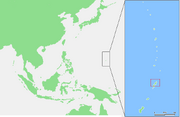
Saipan /saɪˈpæn/ is the largest island of the Northern Mariana Islands, a commonwealth of the United States in the western Pacific Ocean. According to the 2010 United States Census, Saipan's population was 48,220.
During World War II, Japan considered Saipan as part of the last line of defenses for the Japanese homeland, and thus had strongly committed to defending it. The Imperial Japanese Army and Imperial Japanese Navy garrisoned Saipan heavily from the late 1930s, building numerous coastal artillery batteries, shore defenses, underground fortifications and an airstrip. In mid-1944, nearly 30,000 troops were based on the island.
The Battle of Saipan from 15 June to 9 July 1944 was one of the major campaigns of World War II. The United States Marine Corps and United States Army landed on the beaches of the southwestern side of the island, and spent more than three weeks in heavy fighting to secure the island from the Japanese. The battle cost the Americans 3,426 killed and 10,364 wounded, whereas of the estimated 30,000 Japanese defenders, only 921 were taken prisoner. Weapons and the tactics of close quarter fighting also resulted in high civilian casualties. Some 20,000 Japanese civilians perished during the battle, including over 1,000 who committed suicide by jumping from "Suicide Cliff" and "Banzai Cliff" rather than be taken prisoner.
Saipan in Joe Steele[]
After taking Tarawa, Mike Sullivan's punishment brigade spent six months refitting and replacing all casualties with new men before being deployed to take Saipan. Once more the Navy bombarded the Japanese defenses for several days before the troops landed using amtracs. Once more, too many Japanese survived and fired on the attacking troops. The Navy continued to provide air support with carrier aircraft which helped, along with landed tanks, but it was a bloody hand to hand fight.
A few days later, Sullivan saw how in earnest the Japanese were when the remaining forces, including the wounded, and armed or not, charged behind a giant flag. Also, the island had been held by Japan since World War I, so there were many civilians. They were no more willing to surrender than the military. Sullivan was shocked to witness women jumping off cliffs after throwing their children off on the eastern coast rather than yielding.[1]
As part of the opening attack of Operation: Olympic heavy bombers took off from Saipan to bomb targets on Kyushu to assist the landing forces.[2]
References[]
- ↑ Joe Steele, pgs. 292-295, HC.
- ↑ Ibid., pg. 312.
| |||||
| |||||||||||||||||||
